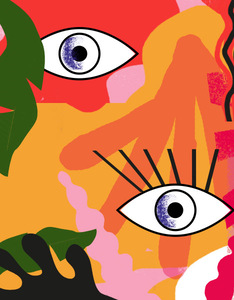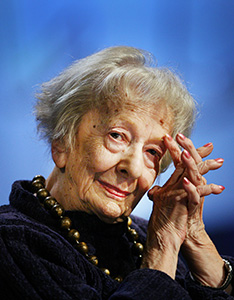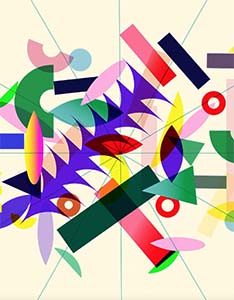Polish contemporary art in Germany. Marek Sobczyk’s rainbow will be installed in front of the Dresden Museum
Two major exhibitions of Polish contemporary art will open in Germany in early November. On 6 November, “Change To Come” – a comprehensive exhibition devoted to engagement in Polish art over the past 80 years, will open at one of Germany’s oldest and largest art institutions: Staatliche Kunstsammlungen Dresden. On 8 November, the first international exhibition devoted to the pioneer of Polish feminist art, Maria Pinińska-Bereś, previously presented at the Four Domes Pavilion, a branch of the National Museum in Wroclaw, will open at the Galerie für Zeitgenössische Kunst in Leipzig. Also in Leipzig, on 7 November, the acclaimed theatre play “Mothers. A Song for Wartime”, directed by Marta Górnicka, which has touched hearts of international audiences and is now completing its international tour, will be presented as part of the euro-scene international dance and theatre festival.
What binds all these projects together is the unwavering belief that individual actions we take have the power to bring about change, says Olga Wysocka, director of the Adam Mickiewicz Institute – a partner to all these events. The Adam Mickiewicz Institute was established to bring Polish culture closer to people around the world and create space for international dialogue through this. I am glad that we are taking part in events that touch on the topic of social engagement, which is particularly important today. She also added: I am hoping that they will trigger reflection and action in response to the challenges we are facing today.

Przybyszki z przyszłości, In Front of the Main Entrance, 2022, paint on fabric, Collection of Zachęta – National Gallery of Art, Warsaw
First comprehensive exhibition devoted to engagement in Polish art presented in Germany
“Change To Come”, curated by Magdalena Komornicka, is the first such extensive exhibition devoted to engagement in Polish art organised in Germany. Presented in the historic space of Kunsthalle im Lipsiusbau, the exhibition tells the story of the phenomenon of engagement and the need for social, political and artistic change in Polish art over the past decades. It will feature the works of more than thirty male and female artists, living and working in Poland and in the Diaspora, which have been created over the past 80 years. The exhibition will also enter urban space. An installation by Marek Sobczyk will be erected between the Kunsthalle im Lipsiusbau building and the Albertinum on Georg Treu Square. This is a new version of the already iconic “Simple Rainbow”, which may be remembered by the public as standing in front of the Zachęta National Gallery of Art building in Warsaw, for several years animating the space of the Małachowski Square. The work was first installed in front of Zachęta thirty years ago, then it returned in 2019 and became a symbol of rebirth of the Małachowski Square. In 2022, it was dismantled.
At the exhibition, classic figures of Polish art such as Andrzej Wróblewski, Marian Bogusz and Maria Jarema will be presented alongside contemporary male and female artists. They will include artists active during the Martial Law and the Solidarity movement in the 1980s, such as Marek Sobczyk and Włodzimierz Pawlak, as well as “provocateurs” of critical art in the 1990s, such as Katarzyna Kozyra. There will also be those who use irony and a sharp sense of humour, such as Oskar Dawicki and members of the Ładnie Group, which functioned in the early 2000s: Wilhelm Sasnal, Marcin Maciejowski and Rafał Bujnowski. The exhibition will provide an opportunity to explore the artistic, performative and activist practices of a younger generation of male and female artists living or working in Poland, including, among others, Mikolaj Sobczak, Malgorzata Mirga-Tas, Ala Savashevich, Joanna Piotrowska, Veronika Zalewska, Yulia Krivich, Marta Romankiv or the anonymous “Przybyszki z przyszłości” collective.
The exhibition will be accompanied by a performative programme.
The concept for the exhibition was created in 2023 upon invitation by Marion Ackermann, General Director of the SKD, and is a result of cooperation between Hanna Wróblewska – the then Deputy Director of the Warsaw Ghetto Museum, now of the Minister of Culture and National Heritage, and Magdalena Komornicka – the curator.

Andrzej Wróblewski, (Queue), undated, gouache, private collection, courtesy of the Andrzej Wróblewski Foundation
Change To Come
Kunsthalle im Lipsiusbau, Staatliche Kunstsammlungen Dresden
opening: 06.11.2024, 18:30
duration of exhibition: 07.11.2024-16.03.2025
curator: Magdalena Komornicka
curator (SKD): Maria Isserlis
Partners: Adam Mickiewicz Institute, Zachęta National Gallery of Art, Foundation for Polish-German Cooperation
More information:lipsiusbau.skd.museum
A play that deeply resonated with international audiences
“Mothers. A Song for Wartime” is an international co-production directed by Marta Górnicka, which premiered at the Powszechny Theatre in Warsaw in 2023. As part of an international tour, the play was performed across Europe including the prestigious Avignon Festival, where it won over the audience who rewarded the creators with a standing ovation lasting more than a quarter of an hour. The euro-scene festival in Leipzig, where the play will be performed on stage on 7 November, is the last stop on the international tour. The cast will then return to Poland to perform later this year at the Powszechny Theatre and at the Divine Comedy Festival in Cracow.
The choral performance was created by Marta Górnicka based on the testimonies of Ukrainian and Belarusian mothers and children who fled the war and persecution, as well as Polish women who opened the doors to their homes to them. It is a story about the situation of women during the war, the rituals of wartime violence against women and civilians, the defence mechanisms and the sense of responsibility. The play features The Chorus of Women – an ensemble formed by 21 female artists from Poland, Ukraine and Belarus, aged between 9 and 71. Some of them come from Kyiv, Sumy, Irpin or Kherson, and are refugees, witnesses and victims of violence in the war in Ukraine instigated by Russia. Ukrainian counting rhymes, traditional songs, incantations and political statements are mixed together. The performance opens with Shchedrivka (Ukrainian: щедрівка), a traditional Ukrainian song supposed to bring good luck and rebirth.
“When Ukraine screams, we need practices that originate from long before the birth of theatre, brought to the scene by the Choir. We need theatre with its power of change. With its power to remember the most horrible things that the trauma of war would like to remove from sight. The theatre of new forms of solidarity and a new ritual. A place where a better world is imaginable and possible” – Marta Górnicka told Die Zeit in an interview.

fot. Bartek Warzęcha
Spektakl „Matki. Pieśń na czas wojny”
“Mothers. A Song for Wartime”
Location: Euro-scene festival in Leipzig
Date: 07.11.2024
Concept and direction: Marta Górnicka
Cast: Liza Kozlova, Palina Dabravoĺskaja, Svitlana Onischak, Kateryna Taran, Svitlana Berestovskaya, Valeriia Obodianskaya, Sasha Cherkas, Mariia Tabachuk, Yuliia Ridna, Natalia Mazur, Aleksandra Sroka, Katarzyna Yajnicka, Bohdana Zazhytska, Anastasiia Kulinich, Hanna Mykhailova, Katerina Aleinikova, Elena Zui-Voitekhovskaya, Kamila Michalska, Maria Robaszkiewicz, Polina Shkliar, Ewa Konstanciak
More information: euro-scene.de
The work of Maria Pinińska-Bereś, a pioneer of Polish feminist art, presented to the international audience for the first time
The exhibition “Maria Pinińska-Bereś,” which will be on display at the Galerie für Zeitgenössische Kunst in Leipzig from 8 November, is the first comprehensive solo exhibition of one of the most extraordinary personalities of 20th-century Polish art organised in Germany. The retrospective, curated by Heike Munder and Jaroslaw Suchan, will show the work of Maria Pinińska-Bereś to an international public for the first time. In doing so, it interferes with art history in two ways: it questions the widespread focus on male artists and points out that the Western perspective overlooks the diverse and multifaceted art scene of 20th-century Eastern Europe.
Maria Pinińska-Bereś, currently being rediscovered, explored the sphere of femininity and female eroticism, their socio-political entanglements as well as their relationship with the natural world. Central to her poetic and political art is an exploration of femininity and the social constraints associated with it.
Along with Natalia LL or Ewa Partum, Pinińska-Bereś is seen as a pioneer of feminist art in Poland. The artist opposed structural violence from both the state and the church and challenged the art industry. While her sculptural works from the 1950s were still in line with modernist traditions, her later art incorporated influences from the neo-avant-garde movement. She replaced items made of cement or metal with everyday materials such as papier-mâché or wood, and items such as quilts or aprons. In the 1960s, biomorphic forms started to increasingly appear in her works. She enhanced their feminine look with pink colour, which has become her trademark. Pink, as the colour of dollhouses and dresses, functions as an instrument to prepare girls for their social role in the patriarchal society. By appropriating the colour, Pinińska-Bereś criticised the politics of gender roles and referred to traumatic experiences.
Visitors to the exhibition will have a chance to become familiar with a wide selection of works created between the 1950s and the end of the last century, including the most important sculptures and performances.

Maria Pinińska-Bereś, "The Banner", 1980, from the family archives © The Maria Pinińska-Bereś and Jerzy Bereś Foundation und and The Approach, London
“Maria Pinińska-Bereś”
Location: Galerie für Zeitgenössische Kunst, Leipzig
Opening: 08.11.2024
Duration: 08.11.2024-23.02.2025
Curatorial team: Heike Munder, Jarosław Suchan, Małgorzata Micuła (National Museum in Wroclaw)
Cooperation: National Museum in Wroclaw, Kunstmuseum Den Haag
Partners: Adam Mickiewicz Institute, Foundation for Polish-German Cooperation, Cultural Foundation of the Free State of Saxony (Kulturstiftung des Freistaates Sachsen)
More information: gfzk.de
The Adam Mickiewicz Institute (IAM) brings Polish culture to people around the world. Being a state institution, it creates lasting interest in Polish culture and art through strengthening the presence of Polish artists on the global stage. It initiates innovative projects, supports international cooperation and cultural exchanges. It promotes the work of both established and promising artists, showing the diversity and richness of Polish culture. It is also responsible for the Culture.pl website, which is a comprehensive source of knowledge about Polish culture.
More information: www.iam.pl
Media contact: Zuzanna Tartanus, [email protected]


